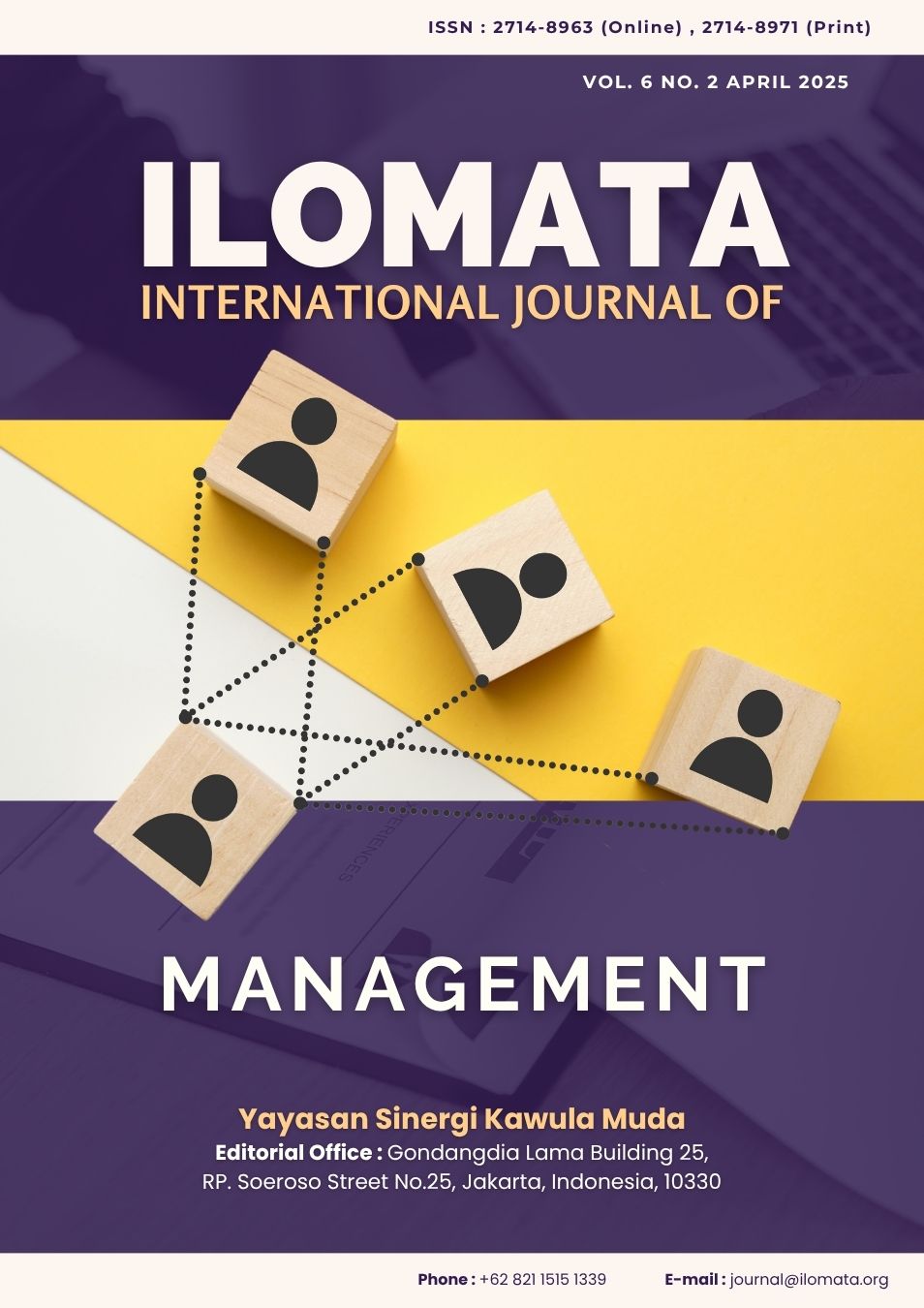Main Article Content
Abstract
The garment industry is currently facing considerable challenges in meeting the demands of overseas buyers. The fast fashion trend has shortened garmen production cycles and forced garmen factories to work with reliable suppliers, especially sewing thread suppliers, to fulfil the production needs of garmen factories in a short period of time. This research emphasises the importance of building strategic partnerships between garmen factories and sewing thread suppliers within the framework of B2B marketing relationships to ensure an effective and sustainable supply chain. Previous research states that there is a positive influence between commitment, trust, and relative dependence on customer satisfaction and customer loyalty in distributor and seller relationships. This study builds a model to further analyse the influence of Affective Commitment, Instrumental Commitment, Capability-based Trust, Benevolence-based Trust, and Relative Dependence factors to achieve customer satisfaction and customer loyalty in the relationship between garmen factories and sewing thread suppliers. The research method used is quantitative method with data collection through surveys sent to garmen factories located in Banten, West Java, and DKI Jakarta Provinces. Data analysis was conducted using SmartPLS to determine the relationship between the research variables.The findings of this study state that Affective Commitment, Instrumental Commitment, Capability-based Trust, and Benevolence-based Trust can increase customer satisfaction and customer loyalty, but relative dependence was found to have no significant effect on customer satisfaction and customer loyalty. These findings provide new insights for companies in developing their business strategies.
Article Details

This work is licensed under a Creative Commons Attribution 4.0 International License.

This work is licensed under a Creative Commons Attribution 4.0 International License.
References
- Abdul-Muhmin, A. G. (2005). Instrumental and interpersonal determinants of relationship satisfaction and commitment in industrial markets. Journal of Business Research, 58(5), 619–628. https://doi.org/10.1016/j.jbusres.2003.08.004
- Arthur, E., Agbemabiese, G. C., Amoako, G. K., & Anim, P. A. (2023). Commitment, trust, relative dependence, and customer loyalty in the B2B setting: the role of customer satisfaction. Journal of Business and Industrial Marketing. https://doi.org/10.1108/JBIM-08-2022-0375
- Caceres, R. C., & Paparoidamis, N. G. (2007). Service quality, relationship satisfaction, trust, commitment and business-to-business loyalty. In European Journal of Marketing (Vol. 41, Issues 7–8, pp. 836–867). https://doi.org/10.1108/03090560710752429
- Chang, Y. , W. X. , S. L. C. A. P. (2021). Chang, Y., Wang, X., Su, L. and Cui, A.P. (2021), “B2B brand orientation, relationship commitment, and buyersupplier relational performance”, Journal of Business & Industrial Marketing, Vol. 36 No. 2, pp. 324-336. Journal of Business & Industrial Marketing, 36(2), 324–336.
- Chong, W. K., Man, K. L., & Kim, M. (2018). The impact of e-marketing orientation on performance in Asian SMEs: a B2B perspective. Enterprise Information Systems, 12(1), 4–18. https://doi.org/10.1080/17517575.2016.1177205
- Dosi, G., Faillo, M., & Marengo, L. (2008). Organizational capabilities, patterns of knowledge accumulation and governance structures in business firms: An introduction. Organization Studies, 29(8–9), 1165–1185. https://doi.org/10.1177/0170840608094775
- Geiger, I., & Naacke, D. (2023). “What’s it really worth?” A meta-analysis of customer-perceived relationship value in B2B markets. Journal of Business and Industrial Marketing, 38(4), 751–773. https://doi.org/10.1108/JBIM-09-2021-0438
- Hair, J. F., Risher, J. J., Sarstedt, M., & Ringle, C. M. (2019). When to use and how to report the results of PLS-SEM. In European Business Review (Vol. 31, Issue 1, pp. 2–24). Emerald Group Publishing Ltd. https://doi.org/10.1108/EBR-11-2018-0203
- Hayes, A. (2024, February 13). Fast Fashion Explained and How It Impacts Retail Manufacturing.
- Hutt, M. D. , S. T. W. (2013). Business Marketing Management: B2B. Cengage Learning.
- Johnson, M. S., Sivadas, E., & Garbarino, E. (2008). Customer satisfaction, perceived risk and affective commitment: An investigation of directions of influence. Journal of Services Marketing, 22(5), 353–362. https://doi.org/10.1108/08876040810889120
- Kemp, E. A., Borders, A. L., Anaza, N. A., & Johnston, W. J. (2018). The heart in organizational buying: marketers’ understanding of emotions and decision-making of buyers. Journal of Business and Industrial Marketing, 33(1), 19–28. https://doi.org/10.1108/JBIM-06-2017-0129
- Kofi Amoako, G., Baadu Adams, G., & Doe, J. K. (2020). Intention to Continue Relationship in B to B Setting–Case of Guinness Ghana Breweries–Some Preliminary Findings. Journal of Business-to-Business Marketing, 27(1), 81–94. https://doi.org/10.1080/1051712X.2020.1713563
- Mungra, Y., & Yadav, P. K. (2020). The mediating effect of satisfaction on trust-commitment and relational outcomes in manufacturer–supplier relationship. Journal of Business and Industrial Marketing, 35(2), 219–230. https://doi.org/10.1108/JBIM-09-2018-0268
- Ozuem, W., Thomas, T., & Lancaster, G. (2016). The influence of customer loyalty on small island economies: an empirical and exploratory study. Journal of Strategic Marketing, 24(6), 447–469. https://doi.org/10.1080/0965254X.2015.1011205
- Padgett, D., Hopkins, C. D., & Williams, Z. (2020). Buyer dependence in B2B relationships: The role of supplier investments, commitment form, and trust. Journal of Business Research, 119, 13–24. https://doi.org/10.1016/j.jbusres.2020.07.019
- Rong, W., Arnold, M. J., & Carlson, B. D. (2020). Brand outcomes in sales channel relationships: a guanxi theory perspective. Journal of Business and Industrial Marketing, 36(7), 1191–1212. https://doi.org/10.1108/JBIM-03-2020-0163
- Rungsithong, R., & Meyer, K. E. (2024). Affect-based dimensions of trust: a study of buyer-supplier relationships in Thai manufacturing. Journal of Business and Industrial Marketing. https://doi.org/10.1108/JBIM-10-2022-0443
- Shania Cooper. (2023, March 10). The impact of social media on the fashion industry The role influencers have on trends. Meer.
- Sharma, N. (2022). How core, technical and social components of business relationship value drive customer satisfaction and loyalty in high tech B2B market. Journal of Business and Industrial Marketing, 37(5), 975–994. https://doi.org/10.1108/JBIM-12-2020-0554
- Thornquist, C. (2018). The Fashion Condition: Rethinking Fashion from Its Everyday Practices. Fashion Practice, 10(3), 289–310. https://doi.org/10.1080/17569370.2018.1507147
- Zhang, C. B., & Li, Y. (2019). How social media usage influences B2B customer loyalty: roles of trust and purchase risk. Journal of Business and Industrial Marketing, 34(7), 1420–1433. https://doi.org/10.1108/JBIM-07-2018-0211

